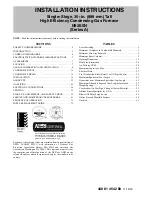
WARNING:
FIRE AND EXPLOSION HAZARD
Failure to follow this warning could result in fire,
property damage, personal injury, or death.
Solvent cements are combustible. Keep away from heat,
sparks, and open flame. Use only in well ventilated areas.
Avoid breathing in vapor or allowing contact with skin or
eyes.
WARNING:
CARBON MONOXIDE POISONING
HAZARD
Failure to follow this warning could result in property
damage, personal injury, or death.
All combustion-air and vent pipes must be airtight and
watertight. Pipes must also terminate exactly as shown in
Fig. 37, 38, 39, 40, or 41.
NOTE:
The minimum combustion-air and vent pipe length (each)
for these furnaces is 5 ft. Short pipe lengths (5-8 ft) may discharge
water droplets. These droplets may be undesirable, and a 12-in.
minimum offset pipe section is recommended, as shown in Fig. 35,
to reduce excessive droplets from exiting vent pipe outlet.
COMBUSTION-AIR AND VENT PIPE DIAMETER
Determine combustion-air and vent pipe diameter.
1. Using Table 7, individually determine the smallest
combustion-air and vent pipe diameters. Pick the larger of
these 2 pipe diameters and use this diameter for both
combustion-air and vent pipes.
2. When installing vent systems of short pipe length, use the
smallest allowable pipe diameter. Do not use pipe size
greater than required or incomplete combustion, flame
disturbance, or flame sense lockout may occur.
NOTE:
Do not count elbows or pipe sections in terminations or
within furnace. See shaded areas in Fig. 37, 38, 39, 40, and 41.
EXAMPLE:
An 042080 size furnace located in Indianapolis, elevation
650 ft above sea level, could be installed in an application
requiring 3 elbows and 17 ft of vent pipe, along with 5
elbows and 16 ft of combustion-air pipe. Table 6 indicates
this application would allow a 1-1/2-in. diameter vent pipe,
but require a 2-in. diameter combustion air pipe (1-1/2-in.
pipe is good for 20 ft with 3 elbows, but only 10 ft with 5
elbows). Therefore, 2-in. diameter pipe must be used for
both vent and combustion-air pipes since larger required
diameter must always be used for both pipes. If same
installation were in Albuquerque, elevation 5250 ft above
sea level, installation would require 2-in. vent pipe and
combustion-air pipe. At 5001- to 6000-ft elevation, 1-1/2-
in. pipe is not allowed with 5 elbows, but 2-in. pipe is good
for 68 ft with 5 elbows.
COMBUSTION-AIR AND VENT PIPE ATTACHMENT
NOTE:
All pipe joints must be cemented except attachment of
combustion-air pipe to inlet housing connection since it may be
necessary to remove pipe for servicing.
1. Attach combustion-air pipe as follows:
a. Determine location of combustion-air intake pipe con-
nection to combustion-air intake housing as shown in
Fig. 34 for application.
b. Reposition combustion-air intake housing plug fitting in
appropriate unused intake housing connection.
c. Insert perforated disk assembly (factory supplied) in
intake housing where combustion-air intake pipe will be
connected.
d. Install pipe support (factory-supplied in loose parts bag)
into selected furnace casing combustion-air pipe hole.
Pipe support should be positioned to bottom of casing
hole.
e. Insert 2-in. diameter pipe into intake housing.
NOTE:
A 2-in. diameter pipe must be used within the furnace
casing. Make all pipe diameter transitions outside furnace casing.
f. Install casing hole filler cap (factory-supplied in loose
parts bag) in unused combustion-air pipe casing hole.
g. Drill a 1/8-in. hole in 2-in. combustion-air pipe using
hole in intake housing as a guide.
h. Install a field-supplied No. 6 or No. 8 sheet metal screw
into combustion-air pipe.
NOTE:
DO NOT OVERTIGHTEN SCREW. Breakage of intake
housing or fitting may cause air leakage to occur.
NOTE:
Do not attach combustion-air intake pipe permanently to
combustion-air intake housing since it may be necessary to remove
pipe for service of igniter or flame sensor.
COMBUSTION-AIR INTAKE HOUSING PLUG
FITTING
The combustion-air intake plug fitting must be installed in
unused combustion-air intake housing. This fitting must be
attached by using RTV sealant, or by drilling a 1/8-in. hole
in fitting, using hole in intake housing as a guide. Install a
field-supplied No. 6 or No. 8 sheet metal screw.
NOTE:
DO NOT OVERTIGHTEN SCREW. Breakage of intake
housing or fitting may cause air leakage to occur.
A plugged drain connection has been provided on this
fitting for use when moisture is found in combustion-air
intake pipe and combustion box.
Fig. 34—Combustion-Air and Vent Pipe Connections
A96187
COMBUSTION-
AIR
COMBUSTION-
AIR
AIR
FLOW
VENT
VENT
VENT
AIR
FLOW
AIR
FLOW
AIR
FLOW
UPFLOW
DOWNFLOW
HORIZONTAL-LEFT DISCHARGE
HORIZONTAL-RIGHT DISCHARGE
Select 1 vent pipe connection and
1 combustion-air pipe connection.
COMBUSTION-
AIR
COMBUSTION-
AIR
COMBUSTION-
AIR
COMBUSTION-
AIR
VENT
VENT
VENT
NOTE:
Select 1 vent pipe connection and
1 combustion-air pipe connection.
NOTE:
—27—
Summary of Contents for CONDENSING GAS FURNACE 355MAV
Page 51: ... 51 ...
















































